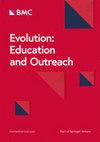What can student-generated animations tell us about students’ conceptions of evolution?
Q1 Social Sciences
引用次数: 0
Abstract
Background A large body of research has investigated students’ conceptions of evolutionary changes and emphasizes that students have alternative conceptions about their causes. A conventional way to monitor students’ conceptions is through inventories where researchers analyse their written answers. However, textbooks are being increasingly complemented with, or even replaced by, various multimedia materials where multiple modes are used to communicate evolutionary processes. This has profound implications for students’ learning, and highlights that allowing different modes of expression may influence which knowledge they present. Therefore, the goal of this exploratory study is to expand the understanding of students’ conceptions of evolution through natural selection by applying student-generated stop-motion animations to reveal their conceptions. Forty-seven Swedish upper secondary school students generated 18 animations concerning evolution through natural selection. We analysed these animations qualitatively using content analysis to reveal key concepts, alternative conceptions and connections between organizational levels and time. This analysis is related to findings from previous studies on students’ conceptions of evolutionary change. Results Our study highlights some of the benefits and limitations of using these two assessment methods. In terms of identifying alternative conceptions, a clear difference between the results of the two methods of assessment was observed. In particular, the alternative conception of essentialism appeared to a lesser extent in the student’s animations than in their written responses, while natural selection as an event was more prevalent. Conclusions These findings support the view that students’ expression of different misconceptions is influenced by the context and representational form. The work also reveals that generating stop-motion animations to explain scientific concepts is an engaging approach that stimulates students to explore their understanding in a creative and personal manner. This is potentially positive for engagement and learning. The potential for complementing standard paper-and-pen tests with tasks that encompass stop-motion animations is also discussed.关于学生的进化观,学生制作的动画能告诉我们什么?
背景大量研究调查了学生对进化变化的概念,并强调学生对其原因有不同的概念。监测学生概念的一种传统方法是通过清单,研究人员分析他们的书面答案。然而,教科书正越来越多地被各种多媒体材料所补充,甚至取代,在这些材料中,多种模式被用来交流进化过程。这对学生的学习有着深远的影响,并强调允许不同的表达方式可能会影响他们所呈现的知识。因此,本探索性研究的目标是通过应用学生生成的定格动画来揭示学生的概念,通过自然选择来扩大对学生进化概念的理解。47名瑞典高中生制作了18部关于自然选择进化的动画。我们使用内容分析对这些动画进行了定性分析,以揭示关键概念、替代概念以及组织级别和时间之间的联系。这一分析与之前关于学生进化变化概念的研究结果有关。结果我们的研究强调了使用这两种评估方法的一些好处和局限性。在确定替代概念方面,观察到两种评估方法的结果之间存在明显差异。特别是,本质主义的替代概念在学生的动画中出现的程度低于他们的书面回应,而自然选择作为一种事件更为普遍。结论这些发现支持了这样一种观点,即学生对不同误解的表达受到上下文和表征形式的影响。这项工作还表明,制作定格动画来解释科学概念是一种吸引人的方法,可以激励学生以创造性和个人的方式探索他们的理解。这对参与和学习具有潜在的积极意义。还讨论了用包含定格动画的任务来补充标准纸笔测试的潜力。
本文章由计算机程序翻译,如有差异,请以英文原文为准。
求助全文
约1分钟内获得全文
求助全文
来源期刊

Evolution: Education and Outreach
Social Sciences-Education
CiteScore
4.40
自引率
0.00%
发文量
15
审稿时长
13 weeks
 求助内容:
求助内容: 应助结果提醒方式:
应助结果提醒方式:


